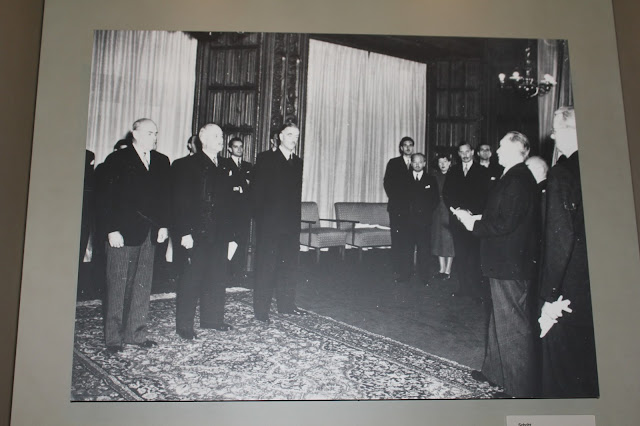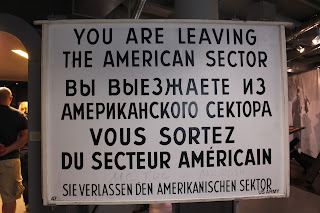Today we went from Dresden to Leipzig by train. It was very nice and was much more comfortable and relaxing then the last train we were on. Even though we were still only in 2nd class, we sat in a "quiet zone" of the train and managed to grab a couple seats in the front where we could share a table. We managed to sneak in a game of cribbage. I just finished the last bit by listening to some music, and my mom took pictures of graffiti, which seems to be her latest thing!
For most of our trip in Germany, we are located in what was known as the GDR, or East Germany. Leipzig is no exception. In fact, Leipzig has a very significant history as part of the GDR. It is where the most significant uprising against the Socialist totalitarian rule took place, and began the trend of other uprisings, which ultimately led to the reunification of an entire Germany in the latter part of 1989.
Our little guide book, which we have paid little to no attention to because we have been on tours with guides and have had little use for other information, gave us some ideas on what to see here. One of the reasons for this is that, though we knew we were coming to Leipzig for a short period of time, we received no vouchers or information regarding our stay here, other than our train ticket saying that we were going from Dresden to here, and that we had an idea of what hotel we were going to be in due to a package we got back prior to our trip from our trip advisor. Nonetheless we are here!
But in the city guide, there was an interesting mention of a particular museum called the Zeitgeschichtliches Forum. Say that word 10 times fast! Actually, just try saying it once. Translated it means "contemporary history." This museum depicted the history of the GDR from division and dictatorship to the fall of the Wall. The museum showed the actual materials from the period of time including Checkpoint Charlie, numerous film clips and pictures of Germans being stunned by the building of the wall, and how people in the GDR lived in a very oppressive situation.
Lots was said about the Stasi (The Ministry for State Security), which was East Germany's secret police force. They had massive powers to deal with people who showed glimpses of opposition to the Socialist government. Stasi propaganda and surveillance footage was very common during this time, and a theme of the museum. Very interesting! In all the museum showed the GDR's extensive zeal towards the controlling of its people, and its oppressive ways to keep out the Fascists from the West!
I will try and show a few pictures and have a quick caption of what the photo is and the story behind it. There are many things on display that have a vast and interesting story behind it. Here are just some of the interesting highlights that we saw.
"and they may whimper, remains icy cold! Remember the victims of Buchenwald." Basically, showing the Nazis whimpering for forgiveness.
The SED was created in 1946 when the Social Democrats in Germany and the Communist Party of Germany aligned with one another. The governed until the election of 1990. They were regarded as a totalitarian regime in East Germany. This flag was handmade and was hung behind the first GDR President's desk.
Konrad Adenauer with the other 3 Allied occupants. As you might see, Adenauer stepped on the carpet, which was controversial. The 3 Allies certainly didn't want this and their faces show it! Adenauer said he wanted to show that Germany had changed and was now a free and democratic society, as well as being aligned with the Allies. Someone behind him in the picture said it was crowded and he just got pushed...
The last two photos show Hans-Joachim Nather. He was a 20 year old German dissident and an opposition fighter in East Germany. He was executed in the USSR in 1950 because he built the radio blocking device (as seen above) that would intercept a speech commemorating Stalin by Wilhelm Pieck , the founder of the Socialist Unity Party and President of the GDR. Nather actually tried to speak into a microphone, but apparently no one heard it. Regardless, parts of the radio blocker were found and Nather and his colleagues were arrested. Nather was the only one given the death sentence. Others were given about 10 years. Later, one of the other people associated with Nather, used similar parts found from this era to create the exact replica model made by Nather for the newly built museum that we saw today!
In 1953, there was a workers strike in East Germany. It didn't turn out too well for the strikers. See below image.
A class of students just prior to their graduation. They had stood for a moment of silence to commemorate the people killed in the above riot. The Stasi started investigating and they decided they had best escape East Germany, but weren't sure how. 14 boys and 2 of the girls managed to get out just weeks prior to their graduation! They managed to complete their education in West Germany.
A well known sign prior to the wall.
The first wall prior to the bigger one, which was built in 1961 (See image below). What is crazy about these images is that when we got to the museum, the guide was excited to tell us that the beginning stages of the wall being built started on August 13, 1961!!! Just happened to be the same day we visited the museum. Quite the anniversary!
Original blocks! Were originally for houses.
Very famous image of a young man, Peter Fechter, trying to escape to the West. This image was taken just prior to him being shot and, subsequently, left on the ground for an hour where he bled to death. His friend who he was escaping with, managed to climb the fence first and made it out alive. Unfortunately, and astonishingly, this image was captured by a soldier standing in the Western sector!!! So he was on western ground. Amazing! And sad.
Stasi van. Used to put dissidents into custody. As you can see by the below image, the cells in the truck had no windows or light. This was a torture device by the Stasi!
Apartments were built all over German cities. Socialist ones had bathrooms with running water and flushing toilets. These were nearly non-existent before then. They had patios too. These were a great luxury. Unfortunately, there were never enough, and so people still remained in very oppressive situations. Food was very scarce and lineups were huge. People had to be at a bakery at 3am just to get bread.
Image of the Stasi commander's office. Wallpaper and curtains and some other things were original. Taken from the actual office.
Images seen from all over the world.
Original fence that people climbed at the Czech embassy.
The most ridiculous car in the world. Made out of cardboard. Was a highly prized asset in the GDR. It would take 15 years to get one. Watch the movie "Goodbye Lenin," and it will give you an idea of what it was like to live in these times.
I think this was the most amazing artifact. The American flag used parts of the former Nazi flag to symbolize their winning of the war. The red part was taken from the red of the Nazi flag and the white strips were from the Swastika. Absolutely amazing.
Of course, like in Vancouver during our Olympics, Germany hosted the FIFA World Cup for soccer. But, even before this Germany had been very prominent on soccer's world stage. It is staggering to think that even in 1954 they won that year's World Cup too! But I digress. This event, I believe in 2002, triggered an out-pouring of national pride. Before this apparently, the black, red, and yellow flag still brought back the memory of the Nazi times. After this, there was a true sense of German unification. Reunification didn't happen over night, or when the wall came tumbling down. It took years. It is still happening today. Even when I look out my hotel window, I see things being built that before was just a hole in the ground--evidence of a war-torn country.
It is amazing to think that it was in my life time, albeit a very young one, that this country was divided for such a long time. Funny enough, the Socialist regime in 1989 celebrated, I believe in October that year, the 40th anniversary of their country. It is amazing to think, and to hear from our guide, that it was not even apparent that even 2 months later people's lives were going to change forever. People even thought that though the wall had opened, there was still the chance that the wall would potentially close back up again. People still had those fears.
I keep rambling. What did I think before about the value of historical knowledge? To become wiser? This is proof that I was right!
Tomorrow we are off to Nuremberg. I am looking forward to this because this is where the Nazi rally ground is, and we are doing a Hitler and Third Reich walking tour around the city the next day. Can't wait!
Oh...hey, I forgot, we saw Johann Sebastien Bach's tomb, as well...
Prost! Ich denke, ich werde gehen und ein Bier trinken heute Abend!



























No comments:
Post a Comment